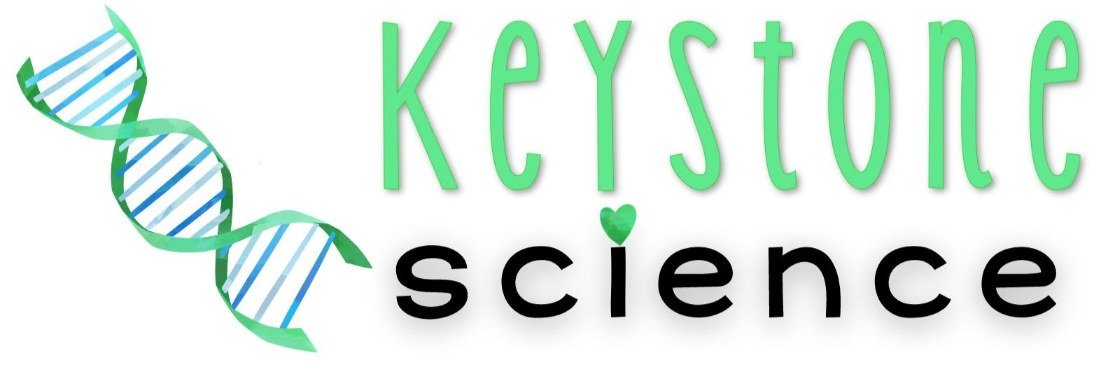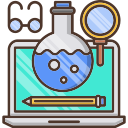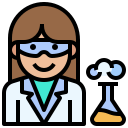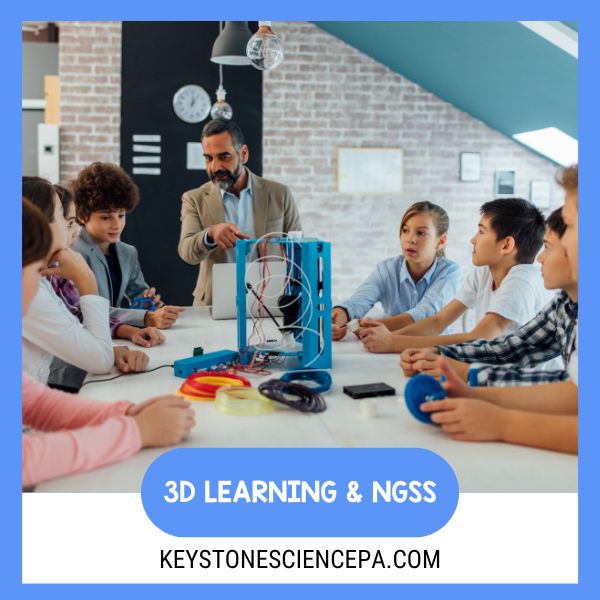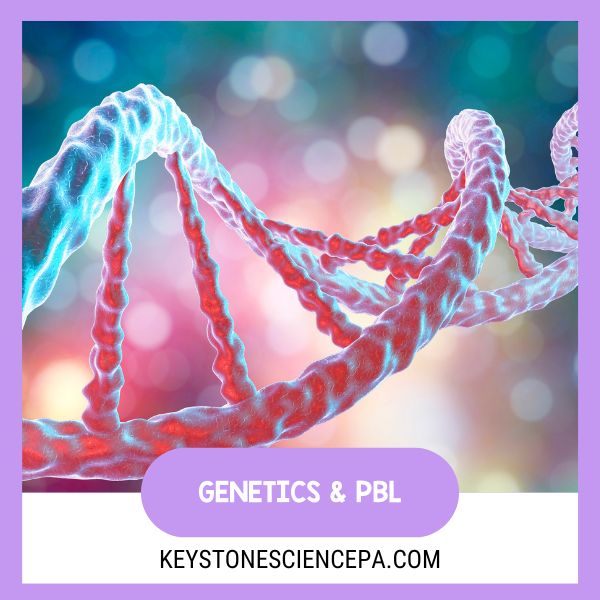Hey there, welcome back to my NGSS and PA STEELS journey! In this next part of the series, I’m diving into the fascinating world of 3D learning. If you’re a high school science teacher already working with NGSS, this post is going to feel like leveling up your teaching game. I’ll share how to weave together Science and Engineering Practices, Crosscutting Concepts, and Disciplinary Core Ideas into something truly impactful. If you missed my first post on NGSS and STEELS, no worries—catch up when you can so you’re all set for this 3D learning adventure. Let’s make this journey awesome together!
Science & Engineering Practices
Science and Engineering Practices (SEPs) are like a set of eight go-to techniques that scientists and engineers use to figure out how the natural world works. These practices aren’t just about studying—they’re all about getting hands-on and digging into the details of science. Think of them as your backstage pass to exploring and investigating. Sound exciting? Let’s break down each of these SEPs and see how they work. Time to dive in!

- Asking Questions and Defining Problems
This one’s all about sparking that inner detective in students. We encourage them to throw out open-ended questions and spot real-world problems to dig into. It’s like diving headfirst into a treasure hunt of scientific curiosity. Whether it’s coming up with wild guesses (aka hypotheses), figuring out the ‘why’ of things, or realizing where our knowledge has its limits, this practice keeps that fire of curiosity burning. - Developing and Using Models
Think of models as our scientific sidekicks, helping us simplify the complex stuff. In this practice, students get to craft their own mini-versions of things to show what’s going on. It’s like creating a mini-movie to understand the big blockbuster. And as they fine-tune these models with data and observations, they get a real feel for how scientists put ideas together. - Planning and Carrying Out Investigations
This one’s the hands-on adventure! Students step into the shoes of explorers. They cook up experiments, grab data, and really take a close look at things. It’s like they’re the Sherlock Holmes of science, making decisions about how to collect info, where things might go wrong, and how to sort out all those clues. - Analyzing and Interpreting Data
In a world bursting with info, being able to read data like a pro is gold. Students learn how to pull meaning from numbers, spot trends, and make solid conclusions based on evidence. It’s like becoming a data detective, finding those patterns and making some savvy calls. - Using Mathematics and Computational Thinking
Numbers are the secret language of science. Students learn how to use math to talk about relationships in the natural world. And think of computational thinking as a fancy way of saying they’ll use digital tools to crunch data and build models. It’s like becoming math magicians who can make sense of the science puzzle. - Constructing Explanations and Designing Solutions
Now, it’s time to put on the ‘explainer’ hat. Students get to weave together evidence, science smarts, and those core ideas to create well-thought-out explanations or even cook up cool solutions to real-world problems. It’s like they’re becoming the storytellers of science, turning complex stuff into something everyone can understand. - Engaging in Argument from Evidence
This is where the science showdown happens. Scientists don’t just talk; they back up their ideas with evidence. Students learn how to make strong arguments, share their thoughts, and even tackle different opinions. It’s like getting into a friendly debate where everyone’s got some cool facts to back them up. - Obtaining, Evaluating, and Communicating Information
In a world full of information overload, being able to sort through it all is like having a superpower. This practice teaches students how to pick out the good stuff, figure out what’s reliable, and then talk about their findings in a clear and meaningful way. It’s like they’re the news reporters of science, sharing what they’ve found with the world.
The eight SEPs are like the secret ingredient for transforming students into science superheroes. They’re not just learning about science—they’re actively doing it, just like real scientists and engineers. Through hands-on experiments, challenging puzzles, and the same methods professionals use, these SEPs elevate learning to an entirely new level.
Picture students diving into experiments, questioning like detectives, and explaining concepts with confidence. They’re not simply memorizing facts; they’re uncovering the mechanics of how the world works. This approach doesn’t just make science engaging; it makes it unforgettable. These SEPs aren’t just improving education—they’re redefining it.
This isn’t just about acing tests; it’s about cultivating a generation of curious minds who thrive on exploration, problem-solving, and critical thinking. It’s like giving students a backstage pass to the inner workings of science. Armed with these skills, they’re not just students—they’re future leaders, innovators, and problem solvers, ready to face whatever challenges the world sends their way.
The Crosscutting Concepts
Think of the Crosscutting Concepts (CCCs) as the ultimate connectors in science—they serve as bridges linking various scientific disciplines. These concepts bring different areas of science together, creating a cohesive framework for understanding. And the Crosscutting Concepts? They’re essential elements that appear across every corner of science, helping to unify and connect ideas.

Patterns
First, let’s talk about Patterns. This concept serves as a foundational tool in science, helping us identify recurring shapes, behaviors, and trends across various fields. Whether examining cells under a microscope, observing the phases of the moon, or analyzing chemical reactions, recognizing Patterns provides a framework for uncovering order amidst complexity.
Cause and Effect
Next, let’s explore Cause and Effect. This concept acts as the detective of science, helping us understand how things work—what causes events to happen and the outcomes that follow. It explains why plants grow towards sunlight, why magnets stick to refrigerators, and why planets orbit the sun. In essence, it’s science’s way of demonstrating, “If this happens, then that will follow.”
Scale, Proportion, and Quantity
Now let’s discuss Scale, Proportion, and Quantity. This concept acts as a crucial tool in science, allowing us to analyze how changes in size or quantity impact systems and phenomena. From the microscopic scale of atoms to the vastness of galaxies, this principle helps us understand and interpret the underlying mechanisms at play, revealing the intricate connections behind the scenes.
Systems and System Models
Systems and System Models are essential concepts in science, focusing on understanding how different components work together seamlessly. Much like analyzing a car engine to see how each part contributes to its performance, these ideas help us break down complex systems. Whether it’s ecosystems in nature or machinery in the lab, Systems and System Models provide valuable insights into how the pieces interconnect and function as a whole.
Energy and Matter
Ready to dive into the fundamentals of science? Energy and Matter are here to take center stage. Together, they help explain how things move, transform, and interact in the world around us. Think of them as key players in an ongoing scientific performance—energy drives the action while matter adapts and changes form. From powering batteries to bouncing balls, Energy and Matter are at the heart of it all.
Structure and Function
Introducing Structure and Function—concepts that serve as the architects of science, shaping how things are built and how they operate. They explain why a bird’s wings are aerodynamically shaped, why leaves are equipped with tiny pores, and why our cells are intricately organized. Structure and Function provide a framework for understanding the design principles of the natural world.
Stability and Change
Finally, we come to Stability and Change. This concept acts as the weather forecaster of science, helping us understand what remains constant and what evolves over time. It explains why some species thrive while others go extinct, why water freezes at a specific temperature, and why your favorite snack eventually decomposes. Stability and Change provide insight into the balance and transformations occurring all around us.
Crosscutting Concepts serve as essential guides for understanding the interconnected nature of science. They act as tools to navigate across different disciplines, making the learning process both engaging and insightful. By grasping these concepts, you’re not just memorizing facts—you’re gaining a deeper understanding of how everything fits together in the larger framework of science. It’s a reminder that, in science, everything is connected.
Disciplinary Core Ideas
Now, let’s move on to the heart and soul of scientific understanding: Disciplinary Core Ideas (DCIs). These serve as the foundational building blocks of science, providing the essential concepts that underpin four key scientific disciplines: Physical Science, Earth and Space Science, Life Science, and Engineering, Technology, and Applications of Science. These ideas encompass the fundamental principles, theories, and knowledge that drive scientific inquiry and understanding.

Physical Science
Imagine diving into the world of Physical Science. Here, DCIs cover everything from matter and energy to forces and motion. It’s like peeking into the secrets of atoms and molecules, understanding how things move, and exploring why things act the way they do. Think about concepts like conserving energy or uncovering the hidden properties of matter. This is the stuff that lays the groundwork for understanding the mechanics of the universe.
Earth and Space Science
Now, picture venturing into Earth and Space Science. These DCIs take you on a cosmic adventure, from the Earth’s surface to the far reaches of space. They’re about the systems that shape our planet, the water cycle, climate changes, and the epic story of how the universe came to be. It’s like stepping into the shoes of a detective, investigating Earth’s past, its place in the cosmos, and all the magic that happens above us.
Life Science
Next up: Life Science. These DCIs are all about the wonders of life, from tiny cells to entire ecosystems. It’s like diving into the intricate world of genetics, understanding how life adapts and evolves, and uncovering the dance of energy in ecosystems. This is where you grasp the beauty and complexity of life’s diversity, like piecing together a massive puzzle of living things.
Engineering, Technology, and Applications of Science
And then there’s the exciting realm of Engineering, Technology, and Applications of Science. Here, DCIs are all about using scientific know-how to solve real-world problems. It’s like becoming an inventor or an engineer, understanding how to design solutions and navigate the complex relationship between science and technology. Think optimization, constraints, and creative problem-solving—it’s all part of the game.
When you mix these DCIs with Science and Engineering Practices (SEPs) and Crosscutting Concepts (CCCs), you’re creating a whole new way of learning. It’s not just about memorizing facts; it’s about diving into real science action. By doing experiments, crafting models, and embracing scientific techniques, you’re not just understanding science—you’re living it. And guess what? This way of learning sets you up not just for acing tests, but for tackling the big, real-world challenges that lie ahead. It’s like becoming a science superhero, ready to take on anything that comes your way.
Benefits of 3D Learning
Alright, let’s dive into the awesomeness of 3D learning and why it’s the latest hype in science education:
Sparking Lifelong Curiosity: With 3D learning, you’re not just pouring knowledge into students’ minds; you’re igniting a flame of curiosity. They become active explorers, asking questions, seeking answers, and diving deeper into the “whys” and “hows.” This curiosity doesn’t stop at the classroom door; it sticks with them, making them eager to learn and discover throughout their lives.
Mastering Practical Skills: 3D learning isn’t just about theories and concepts; it’s about hands-on skills that matter. Students aren’t passive observers; they’re scientists and problem solvers in the making. They analyze data, design experiments, and collaborate like professionals. These skills are a toolkit they’ll carry into whatever field they choose, preparing them for the real world’s challenges.
Connecting Learning to Reality: Science isn’t confined to textbooks; it’s all around us. 3D learning bridges the gap between the classroom and reality. Students see how science is intertwined with their daily lives, from the food they eat to the technology they use. This connection makes learning meaningful and impactful, turning students into informed citizens who understand and engage with the world around them.
So, when you embrace 3D learning, you’re not just teaching science; you’re shaping future thinkers, problem solvers, and informed citizens who are ready to take on whatever the world throws at them. It’s like giving them a toolkit that’s way cooler than any textbook. It’s a whole new way of learning that’s exciting, engaging, and, most importantly, life-changing.
Strategies for Effective 3D Learning Implementation
Integrating SEPs into Lessons: Think of SEPs as the heartbeats of your lessons. Instead of just pouring out facts, make your classroom a hub of scientific exploration. Set up hands-on experiments that allow students to touch, feel, and see science in action. Encourage them to analyze data, make observations, and construct models. It’s like turning your classroom into a mini laboratory where they’re the scientists, discovering and learning by doing. This approach not only deepens their understanding but also fosters a genuine passion for scientific inquiry.
Utilizing CCCs for Connection: Crosscutting Concepts (CCCs) are like the bridges between science subjects. They show students that science isn’t a bunch of isolated facts; it’s a web of interconnected ideas. As you teach, bring out these concepts to demonstrate how a principle in biology connects with a concept in physics or chemistry. Show them that scientific thinking isn’t confined to a single subject—it’s a way of understanding the world around us. This approach widens their perspective and encourages them to see the bigger picture.
Aligning DCIs with Performance Expectations: Disciplinary Core Ideas (DCIs) are like the anchors of your teaching. They’re the foundational principles that hold your lessons together. When you align these DCIs with NGSS performance expectations, you’re creating a roadmap for comprehensive learning. Craft your lessons around these core ideas while integrating SEPs and CCCs. It’s like building a puzzle where every piece fits perfectly, creating a holistic understanding of science. This approach ensures that students don’t just skim the surface; they dive deep into the heart of scientific concepts.

Overcoming Challenges in 3D Learning
Embarking on the voyage of 3D learning in your science classroom is a thrilling but intimidating endeavor. Below are 3 common obstacles you might face as you transition to this method of teaching with actionable steps to give you and/or your teacher team a roadmap for a seamless integration of 3D Learning in your classroom.
Time Constraints and Resources: Striking the right balance between your tried-and-true content and the exciting world of 3D learning is key; especially in the beginning when you are just getting your feet wet teaching in a new way.
- Prioritize Your Goals: Identify the core 3D practices and concepts that align with your curriculum. Focus on a handful that resonate most with your teaching style and student needs.
- Curate Resources: Dive into the wealth of online resources tailored to 3D learning. Leverage these tools to enhance your teaching without overwhelming your schedule.
- Collaborative Genius: Pool your creative energies with fellow educators. Share ideas, activities, and approaches to effectively integrate 3D learning into your lessons.
Measuring Student Progress: Shifting from conventional testing to assessing 3D learning requires a strategic approach. You are no longer assessing your students on memorizing facts, terms, or processes; 3D Learning is all about assessing how your students use their knowledge or information to solve novel problems, scenarios, or case studies. Traditional assessments should be paired with projects, lab reports, or oral assessments.
- Craft Performance Tasks: Develop performance-based assessments that require students to apply their 3D skills. Think experiments, projects, and presentations that showcase their understanding.
- Argue It Out: For high school biology or chemistry, set the stage for students to construct and defend scientific arguments. This not only assesses their grasp of concepts but also sharpens their critical thinking.
Shift from Traditional to 3D Learning: Moving from traditional teaching methods to 3D learning might seem daunting. Start small, infuse one or two practices or concepts, and build from there. Embrace a growth mindset as you adapt your teaching style. My next blog post will cover some of this in more detail and you will get some goodies to help you with this process!
- Start Small: Begin with a couple of 3D practices or concepts. Choose ones that naturally fit into your existing lessons or units. First focus on one unit of study and one lab or activity in that unit to adapt.
- Trial and Reflect: Integrate the selected practices and concepts and observe the impact. Reflect on what worked well and what could use adjustments. Do your students need more content up front? Different question or discussion stems or techniques? Is there scaffolding you could put in place that will be gradually removed as the year progresses?
- Gradual Expansion: As you gain confidence, gradually expand the incorporation of 3D elements across more lessons. It gets easier with time and experience. If you focus on just one activity in each unit throughout the year, by the end of the year you will have one three-dimensional activity in each of your units to expand on the next school year.
- Feedback Loop: Encourage student feedback on the new approach. Their insights can guide your adjustments and improvements. I love giving my students anonymous midpoint and end of course surveys to get a pulse on their feelings about and in the classroom.
- Growth Mindset: Embrace the mindset of continuous growth. Every step you take brings you closer to a more dynamic and effective teaching style. Teaching is an art that takes years to craft in an effective way.
Your Next Steps
3D learning isn’t just some fancy educational technique; it’s a real game-changer. As high school science teachers, we hold this incredible power to spark curiosity and shape the next generation of scientists. It’s like we’re planting seeds of scientific wonder that will grow into something amazing. By weaving together Science and Engineering Practices, Crosscutting Concepts, and Disciplinary Core Ideas, we’re turning textbook theories into hands-on adventures.
But before we wrap up, don’t forget to dive into our first blog post all about the NGSS. It’s like the foundation for this whole exciting journey. And hey, check out my other series on how to make learning even cooler with inquiry techniques and the magic of phenomena in your science classroom. Want to keep the science party going? Join my email list or catch me on Instagram.
And guess what? There’s more goodness coming your way with the third post in our series: “Planning for the NGSS Using the Curriculum You Already Have.” We’re about to spill the beans on how to seamlessly blend your current lessons with the NGSS alphabet soup. So, let’s keep riding this wave of science education innovation together!
Need more support with inquiry-based learning or the NGSS? Check out my blog series on inquiry learning and NGSS:
- What is inquiry-based learning anyway?
- Inquiry-based learning strategies
- 7 ways to implement phenomena in the science classroom
- Everything you need to know about the NGSS
Let’s Connect!
💡Feel free to explore Keystone Science for ready-to-use high school biology & ecology NGSS aligned notes and activities.
💡Subscribe to my email list for weekly tips direct to your inbox.
💡Follow me on Instagram for daily tips, motivation, and facts you can use in your classroom!
🌟Share in the comments or email me directly 👉🏻 [email protected]
